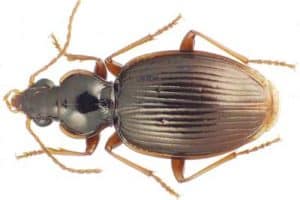Along with being a beautiful tourist destination, Tahiti is also a good place to discover unknown insects.
A Cornell entomologist has known these facts since the early 1990s, when he began traveling to Pacific islands for research.
 Now James Liebherr, professor and curator of the Cornell University Insect Collection, has discovered 14 new beetle species in the Society Islands, all within the genus Mecyclothorax. Liebherr has discovered about half of the 400 total known Mecyclothorax species.
Now James Liebherr, professor and curator of the Cornell University Insect Collection, has discovered 14 new beetle species in the Society Islands, all within the genus Mecyclothorax. Liebherr has discovered about half of the 400 total known Mecyclothorax species.
The genus originated in the Australian region, but there are only 25 species known from Australia, and around 40 more distributed from New Zealand to Java. The most abundant species in Australia can fly, but researchers have discovered 239 flightless species in Hawaii and another 100 in the Society Islands. This phenomenon — a single species dispersing from its place of origin and diversifying into new species elsewhere — is known as adaptive radiation.
The reasons behind “the disparity between the Hawaiian and Society Island radiations versus the source is really the question,” said Liebherr.
The Hawaiian and Society Islands are volcanic mountains that rise out of the water from the sea floor, said Liebherr. Often, lava flows from the mountains and bisects areas of forest. Because the Mecyclothorax species in these areas cannot fly and are only three to seven millimeters long, they become isolated in kipukas, small pockets of land surrounded by lava, and then evolve over time into new species. “The thought is that many Hawaiian insects originated in limited areas within kipukas,” Liebherr said.
The Society Islands exhibit much the same qualities, though the landscape is very vertical with isolated mountain ranges, which may lead to even more diversity.
Liebherr collects the insects by shaking the plants they live on over a nylon sheet, or by spraying a pyrethrum insecticide and collecting the specimens, which are later examined in the lab.
Once discovered, Liebherr often names a new insect based on “an attribute that stands out,” he said. For example, the male of one species had large spines on its back legs that reminded him of a comb, so he named it Mecyclothorax pahere, using the Tahitian word for comb. Another was named for Georges Perrault, the French entomologist who laid the groundwork for classifying Mecyclothorax species of the area starting in the 1970s.
“These animals are signals for habitats in good health,” and when a new discovery is made the area becomes a focal point for conservation efforts, adding a rationale for land managers “to argue for management of a particular area,” said Liebherr.
Mecyclothorax beetles, which belong to the group Carabidae, are small predatory beetles. The beetles undergo a complete metamorphosis within the first month, with a larval, pupal and adult stage. The adults may live up to a year.

